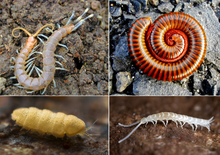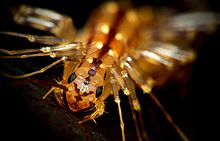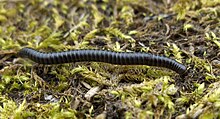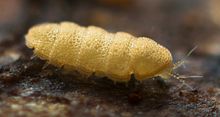Myriapoda
| Myriapods Temporal range:
| |
|---|---|

| |
| Representatives of the four extant myriapod classes. Clockwise from top left: . | |
| Scientific classification | |
| Domain: | Eukaryota |
| Kingdom: | Animalia |
| Phylum: | Arthropoda |
| Clade: | Mandibulata |
| Subphylum: | Myriapoda Latreille, 1802 |
| Classes[1] | |
Myriapods (from
The
The scientific study of myriapods is myriapodology, and those who study myriapods are myriapodologists.[8]
Anatomy

Myriapods have a single pair of
During mating, male myriapods produce a packet of sperm, or spermatophore, which they must transfer to the female externally; this process is often complex and highly developed. The female lays eggs which hatch as much-shortened versions of the adults, with only a few segments and as few as three pairs of legs. With the exception of the two centipede orders Scolopendromorpha and Geophilomorpha, which have epimorphic development (all body segments are formed segments embryonically), the young add additional segments and limbs as they repeatedly moult to reach the adult form.[11]
The process of adding new segments during postembryonic growth is known as anamorphosis, of which there are three types: euanamorphosis, emianamorphosis, and teloanamorphosis. In euanamorphosis, every moult is followed by addition of new segments, even after reaching sexual maturity; in emianamorphosis, new segments are added until a certain stage, and further moults happen without addition of segments; and in teloanamorphosis, where the addition of new segments stops after the adult form is reached, after no further moults occur.[12]
Ecology
| Part of a series on |
Myriapods |
|---|
 |
| Classes |
|
Pauropods |
| Anatomy |
|
Millipede gonopods |
| Notable species |
|
Eopauropus balticus • Scolopendra gigantea • Scutigerella immaculata |
| Interactions with humans |
Myriapods are most abundant in moist forests, where they fulfill an important role in breaking down decaying plant material,
A few species of centipedes and millipedes are able to produce light and are therefore
Although not generally considered dangerous to humans, many millipedes produce noxious
Classification
A 2020 study found numerous characters of the eye and preoral region suggesting that the closest relatives to crown myriapods are the extinct Euthycarcinoids.[21] There are four classes of extant myriapods, Chilopoda (centipedes), Diplopoda, Pauropoda and Symphyla, containing a total of around 12,000 species.[22] While each of these groups of myriapods is believed to be monophyletic, relationships among them are less certain.[23]
Centipedes


Millipedes
Symphyla
Symphylans, or garden centipedes, are closely related to centipedes and millipedes.[28][29] They are 3 to 6 cm long, and have 6 to 12 pairs of legs, depending on their life stage.[28][29][30] Their eggs, which are white and spherical and covered with small hexagonal ridges, are laid in batches of 4 to 25 at a time, and usually take up to 40 days to hatch.[28][29][30] There are about 200 species worldwide.[31]
Pauropoda

Arthropleuridea

Arthropleurideans were ancient myriapods that are now extinct, known from the late Silurian to the Permian. The most famous members are from the genus Arthropleura, which was a giant, probably herbivorous, animal that could be up to 2.63 metres (8 ft 8 in) long,[33] but the group also includes species less than 1 cm (0.39 in). Arthropleuridea was historically considered a distinct class of myriapods, but since 2000 scientific consensus has viewed the group as a subset of millipedes, although the relationship of arthropleurideans to other millipedes and to each other is debated.[34][35]
Myriapod relationships

A variety of groupings (
- Dignatha (also called Collifera) is a clade consisting of millipedes and pauropods, and is supported by morphological similarities including the presence of a collum, a legless segment behind the head.
- Trignatha (also called Atelopoda) is a grouping of centipedes and symphylans, united by similarities of mouthparts.
- Edafopoda is a grouping of symphylans and pauropodans that is supported by shared genetic sequences, yet conflicts with Dignatha and Trignatha.[38]
- Progoneata is a group encompassing millipedes, pauropods and symphylans while excluding centipedes. Shared features include reproductive openings (gonopores) behind the second body segment, and sensory hairs (trichobothria) with a bulb-like swelling. It is compatible with either Dignatha or Edafopoda.[37]
See also
- Euthycarcinoidea, a group of enigmatic arthropods that may be ancestral to myriapods
- Colonization of land, major evolutionary stages leading to terrestrial organisms
- Metamerism, the condition of multiple linearly repeated body segments
References
- ^ "Myriapoda". Integrated Taxonomic Information System.
- ^ a b c Ben Waggoner (February 21, 1996). "Introduction to the Myriapoda". University of California, Berkeley. Retrieved November 9, 2021.
- ^ ISSN 0016-7649.
- S2CID 4270910.
- ^ Rowland Shelley & Paul Marek (March 1, 2005). "Millipede Fossils". East Carolina University. Archived from the original on May 27, 2011.
- .
- S2CID 238220137.
- ISBN 978-0-618-05684-2.
- ^ Deep Metazoan Phylogeny: The Backbone of the Tree of Life. New insights from analyses of molecules, morphology, and theory of data analysis.
- S2CID 6466405.
- ^ ISBN 978-0-03-056747-6.
- .
- Britannica Concise Encyclopedia.
- ^ Barber, A.D. (2009). "Littoral myriapods: a review" (PDF). Soil Organisms. 81 (3): 735–760. Archived from the original (PDF) on 2016-03-03. Retrieved 2013-11-05.
- ^ Barber, A.D., ed. (2013). "World Database of Littoral Myriapoda". World Register of Marine Species. Retrieved 25 October 2013.
- ^ Rosenberg, Joerg; Meyer-Rochow, Victor Benno (2009). Meyer-Rochow V.B. (ed.). Bioluminescence in Focus - a collection of illuminating essays. Research Signpost; Trivandrum, Kerala, India. pp. 139–147.
- ^ "Strange and Unusual Millipedes". herper.com. Archived from the original on April 2, 2012. Retrieved July 2, 2007.
- PMID 11434497.
- .
- PMID 16290034.
- PMID 32253305.
- ^ ISBN 978-0-642-56850-2. Archived from the original(PDF) on 25 October 2007. Retrieved 1 January 2011.
- PMID 15579388.
- ^ "City Centipede: An Urban Legend with Real Legs - TIME". 2008-04-30. Archived from the original on 2008-04-30. Retrieved 2022-10-30.
- PMID 16451739.
- ISBN 978-1-4822-3582-1.
- S2CID 245317751.
- ^ a b c Gesell, Stanley; Calvin, Dennis (2017-03-09). "Garden Symphylan as a Pest of Field Crops".
- ^ a b c University, Utah State. "Sympylans (Garden Centipede)". extension.usu.edu. Retrieved 2022-10-30.
- ^ a b "Symphylan Identification". 2007-08-03. Archived from the original on 2007-08-03. Retrieved 2022-10-30.
- ^ "Numbers of Living Species in Australia and the World" (PDF). 2009-09-26. Archived from the original (PDF) on 2009-09-26. Retrieved 2022-10-30.
- ^ David Kendall (June 6, 2005). "Pauropods & Symphylids". Kendall Bioresearch.
- S2CID 245401499.
- S2CID 129597005.
- PMID 19944188.
- ^ Edgecombe GD; Giribet G (2002). "Myriapod phylogeny and the relationships of Chilopoda" (PDF). In J Llorente Bousquets; JJ Morrone; HP Ulloa (eds.). Biodiversidad, Taxonomia y Biogeografia de Artropodos de Mexico: Hacia una S´ıntesis de su Conocimiento. Univ. Nac. Aut´on Mexico: Prensas Ciencias. pp. 143–168.
- ^ PMID 24535281.
- PMID 23185239.
External links


